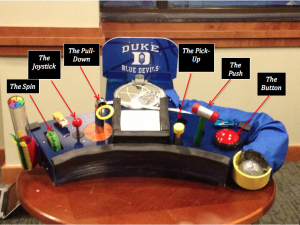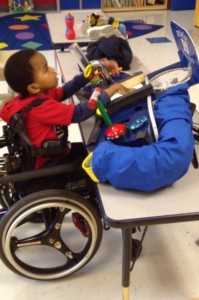Designers: Jordan Cirocco, Halsey Friedel, Sharmila Yadav Palani, Arlens Zeqollari
Client Coordinators: Jane Davis, teacher, and Victoria Guthrie, PT
Supervising Professor: Larry Bohs
INTRODUCTION
Our client is a young boy with a mitochondrial disease that limits his motor control and dexterity, preventing him from independently performing essential tasks such as lifting, reaching, and holding. The goal of this project is to construct a device that encourages him to participate in therapeutic recreation to improve arm control and reaction time. The Buzzer Beater is a desktop game console that promotes functional arm movement by incorporating six entertainment features that require specific arm actions, such as pushing, spinning, and pulling, and a bonus basketball shot. Each successfully performed action results in visual and auditory rewards to stimulate the user and promote cause-and-effect recognition. The Buzzer Beater game console provides a safe, effective, and entertaining method for our client to develop the arm control needed for daily tasks.
SUMMARY OF IMPACT
The Buzzer Beater provides an entertaining method for our client to develop the arm control needed for daily tasks. The device is being used regularly by the client as well as other children in his classroom. His physical therapist commented, “This project went above and beyond what I thought could be put together. This will be a phenomenal asset to the classroom as well as an activity for this special little boy, who has so few activities he can engage with.”
TECHNICAL DESCRIPTION
The Buzzer Beater (Fig. 1) consists of a console, a basketball bonus shot, six entertainment features, and six reward mechanisms. The six entertainment features, labeled in Fig. 1, include the Spin, the Joystick, the Pull-Down, the Pick-Up, the Push, and the Button. The six reward mechanisms include two rotating cars, two recording modules, an LED strip, and a levitating confetti tube.
The acrylic console houses all of the electrical circuits and sensing mechanisms for each of the entertainment features and response mechanisms. The top panel of the console contains custom cuts based on the dimensions of the individual entertainment features. The top panel also features a track, constructed from wood covered in rubber padding, which makes it easier for the client to make a basketball bonus shot. Additional rubber padding on the front edge of the console provides a comfortable armrest. The rear panel provides a 4×1.5” opening to display game play settings on an LCD screen. A 1/8” jack accepts power from a wall-mounted 12V DC supply. Two support legs with rubber feet orient the console at a comfortable angle of 21 degrees and prevent slipping during play. An Arduino microcontroller with associated circuitry senses the completion of tasks and initiates responses.
The basketball bonus shot consists of a hoop and return chute to enable continuous shooting. The return chute supports an infrared sensor that detects a successfully made basket, producing a pink LED response and activating a levitating confetti tube. This tube is constructed from clear acrylic with a motor pointing upward in the bottom, which circulates small pieces of colored foam when activated. The return chute, made from cloth-covered 4” flexible duct, wraps around the back of the device and leads to a PVC cap that catches the ball in front of the user.
The Spin uses a rare earth magnet attached to a commercial wheel. A full revolution is sensed by a Hall effect device, which triggers a white LED response, rotates the left car, and plays an audio recording. The Joystick is a commercial device bolted to the top panel, allowing movement in any direction to trigger a response. The Joystick senses movement n any direction, resulting in a yellow LED response, rotation of the right car, and the playing of an audio recording.
The Pull-Down consists of a curved metal pipe, which houses a rope-spring system connected to a ring. When the ring is pulled, interior magnets produce a voltage change that activates a cyan LED response, the levitating confetti tube, and an audio recording. The spring returns the ring to its original position when disengaged. The Pick-Up is a hollow metal tube with plastic end caps that fits into two holes in the top panel. A piece of copper tape attached to the bottom end of the pick-up produces an electric potential when placed on a copper capacitive touch sensor within the holes, activating a red LED response, rotation of the left car, and the playing of an audio recording.
The Push consists of a metal handlebar with plastic end caps attached to a PVC shaft anchored to a spring within within the console. An interior magnet produces a change in voltage when the feature is pushed toward a Hall effect sensor, which triggers a green LED response, rotates the right car, and plays an audio recording. The Button is a commercial light touch switch that when pushed produces a blue LED response, activates the levitating confetti tube, and plays an audio recording. Figure 2 shows the client using The Buzzer Beater. The cost of the device is approximately $550.

